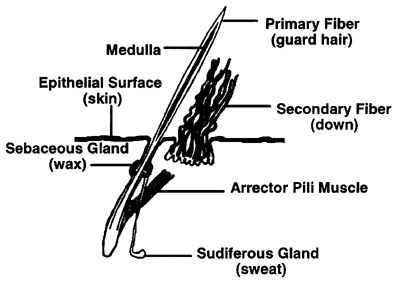
|
Goat Skin Follicle Arrangement |
Introduction:
Cashmere is a superfine "down" fiber produced by the secondary follicles of the goat Capra hircus laniger. It grows as an undercoat during the cooler months of the year. The goat also grows guard hair that sheds cyclically throughout the year, but has no commercial value.There are about 68 breeds of goats from 12 different countries that produce cashmere fiber. Cashmere-type goats range in color from the more prevalent white to the darker browns, greys, and blacks. Goats bearing cashmere, appear "fluffy" as the undercoat grows through the coarse guard hair.
Cashmere Production in the World: The cashmere goat originated in Asia Minor. During the Mogul empire in 15th century India, a large shawl-weaving industry existed involving 40,000 manufacturers in the Indian state of Kashmir. Over the last century, the main producers have been China (90 percent of the world’s total production), Mongolia, Iran, Turkey, and India. Total world production of both guard hair and down is estimated at 5,000 tons each year.
Cashmere production in the United States originated from feral goat populations. Feral goats in some locations of the United States are considered pests, and a government permit is required to capture wild goats. Permits are also required for anyone intending to farm feral goats. Kids born in captivity are not classified as wild and can be run under similar conditions to other farm livestock. The feral goat population in America is basically unknown, but is estimated to be about 20,000 to 75,000. Distribution depends on the presence of predators (foxes, wild dogs) and the environment. Heaviest populations are in the pastoral areas in the Southwest and Pacific Coast regions.
Cashmere Fiber Biology: The anatomical structure that produces fiber is the skin follicle. The primary follicle produces a coarse, medullated guard hair with diameters ranging from 50 to 150 microns. The secondary follicles are non-medullated and produce the down (cashmere fiber) with a mean diameter of 11-18 microns. The secondary to primary follicle ratio (S:P) and follicle density (number per unit area of skin) influence the potential production of the animal.
 |
|
|
Cashmere Fiber Diameter and Length:
Cashmere has a mean fiber diameter between 11 and 18 microns with no down fiber above 28 microns. Processors prefer the 15 to 16 micron cashmere fiber, and this range attracts a premium price. Fiber that averages above 18.5 microns is technically not cashmere, although some overseas processors have shown interest in it. Cashmere fiber lengths range from 10 microns to 70 millimeters (mm) for the woolen system (knitwear) and above 70 mm for the worsted system. The length of the down fiber can be affected by ultraviolet rays, which can damage the exposed tips, causing brittleness. Guard hair length should exceed the maximum down length to protect the down from weathering and harmful ultraviolet rays. Feral goats can have either short, medium, or long guard hair. There is no evidence that guard hair length is related to quantity of cashmere production.Cashmere Color:
Down is produced in a range of colors including white, light grey, dark grey, and brown. White is most desirable color and gives the widest range of alternatives at the dyeing stage. Cashmere color often contrasts with the color of the guard hair.Cashmere Yield:
Cashmere yield is the proportion of down in the total fleece. The yield is expressed as a percentage, and the average cashmere yield from feral goats is 20 percent; however, superior animals have yields up to 45 percent cashmere. Cashmere yield is determined using special machinery that separates down from guard hair. Processors claim to separate cashmere (down) from guard hair to a level of 99 percent purity.Important Cashmere Qualities:
Cashmere has an extremely soft handle and no crimp. These physical properties combine to produce an extremely fine, sleek yarn which produces a garment with very desirable wearing qualities. It is chemically similar to wool and mohair. It absorbs water more quickly than wool and is more sensitive to the effects of chemicals, largely because it is so fine.Utilization of the Fiber:
Cashmere fiber is regarded as one of the most desirable textile fibers, highly sought by the fashion-conscious. Cashmere fabrics are warm, soft, and comfortable. They are used in the manufacture of knitwear garments, sweaters, pullovers, shawls, jackets, suits, rugs, and blankets. Cashmere is used almost exclusively for the production of "classic" upmarket products, which seem to have a stable demand and little price sensitivity. Six goats are needed to produce enough fiber for one sweater or 40 goats for an overcoat.Cashmere Fleece Collection and Marketing:
The total fleece, including guard hair, is shorn from the animal. It is usually classed on the farm and consigned to a central fiber "pool." Most cashmere producers directly oversee classing, objective measurement, and sale preparation of their cashmere fiber. Principal buyers are the USA, Italy, Japan, and Scotland.